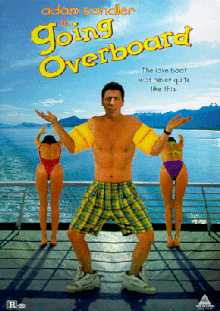Going Overboard
This article needs additional citations for verification. (March 2021) |
| Going Overboard | |
|---|---|
 DVD cover | |
| Directed by | Valerie Breiman |
| Written by | Valerie Breiman |
| Produced by | Mark Daniel Jones Adam Rifkin |
| Starring | Adam Sandler Burt Young |
| Cinematography | Ron Jacobs |
| Edited by | Randy D. Wiles |
| Music by | Steven "Scooby" Scott Smalley |
Production company | L.A. Dreams Productions |
| Distributed by | Theater Technologies, Inc. Vidmark Entertainment |
Release date |
|
Running time | 97 minutes |
| Country | United States |
| Language | English |
| Budget | $800,000 |
Going Overboard is a 1989 American comedy film directed by Valerie Breiman, and stars Adam Sandler in his film debut, Burt Young, Allen Covert, Billy Zane, Terry Moore, Milton Berle, and Billy Bob Thornton in a small role. The film was originally released in 1989, but once Sandler became successful after appearing on Saturday Night Live and starring in the film Billy Madison, it was given a wider release by Vidmark Entertainment in 1995.
Plot[edit]
Shecky Moskowitz (Adam Sandler) is a struggling comedian working on a cruise ship. Shecky gets his chance to be the ship's comedian when it is thought that the regular comedian, Dickie Diamond (Scott LaRose), had fallen overboard and drowned. (Dickie actually locked himself in the men's room.) Shecky is nervous about performing, but King Neptune (Billy Zane) convinces him to go for the opportunity by telling Shecky about the power of laughter. Shecky's first performance is very unsuccessful as he is booed off the stage, he is especially heckled by the construction worker Dave (Billy Bob Thornton). However, after a lecture by Milton Berle, Shecky succeeds in making the audience laugh. At that point, the terrorists come on board and want to kill Miss Australia. Shecky, remembering the advice about the power of laughter, saves her by promising to put the assassins in a film.
Cast[edit]
- Adam Sandler as Shecky Moskowitz
- Burt Young as General Noriega
- Tom Hodges as Bob
- Scott LaRose as Dickie Diamond
- Lisa Collins as Ellen
- Allen Covert as The Bartender
- Billy Zane as King Neptune
- Terry Moore as Mistress
- Milton Berle (credited) as himself
- Billy Bob Thornton as Dave
- Dan Povenmire as Yellow Teeth guitarist
- Steven Brill as Priest
- Peter Berg as Mort Ginsberg
- Adam Rifkin as Croaker / Miss Spain
- Gabe Sachs as Funeral Moaner
- Ricky Paull Goldin as Terrorist Without Shirt
- Warren Selko as Terrorist With Mustache
Production[edit]
Producer Randolf Turrow came up with the idea after he was asked to judge a beauty pageant in Palm Springs, Florida, and learned that the pageant promoters rented a cruise ship filled with beauty contest winners as a publicity stunt. Turrow decided that this gave him a good opportunity to make a film, so he contacted a friend in Texas, Mark Schultz, to finance the film. Turrow contacted Valerie Breiman a week before filming began to write the script. The project went from concept to completion in three months. It was written in three days, cast in one day, prepared in two days and filmed in six days, with two additional days for pick-up shots. The cruise ship denied the filmmakers permission to use any of the public areas with passengers present, so all the shots on common areas were either shot at night or when the passengers were off the ship. The filmmakers then hired some of the onboard staff to be the extras. The film was put together so quickly that the crew forgot the correct lenses, so they had to shoot on incorrect lenses, which is noticeable in some shots.
Release[edit]
The film was first released regionally, as The Unsinkable Shecky Moskowitz, on October 27, 1989. It made its television debut in June 1990 on USA Up All Night and was retitled Babes Ahoy. It was finally released on video in the U.S. in 1995 as Going Overboard, one week after the video release of Billy Madison.
Reception[edit]
On Rotten Tomatoes, the film has four reviews listed, all of which are negative.[1]
David Nusair of Reel Film Reviews gave it zero out of four, and called it "...a slapdash and thoroughly amateurish piece of work that suffers from a total dearth of positive attributes."[2] J.R. Taylor of Entertainment Weekly gave it a grade D.[3]
References[edit]
- ^ "Babes Ahoy (1989)". Rotten Tomatoes. Retrieved 2021-01-01.
- ^ David Nusair (2012). "Two Comedies from TVA - Reviews by David Nusair". ReelFilm.com.
- ^ J.R. Taylor (August 4, 1995). "Going Overboard". Entertainment Weekly.
External links[edit]
- 1989 films
- 1989 comedy films
- 1989 directorial debut films
- 1980s sex comedy films
- American comedy films
- American sex comedy films
- 1980s English-language films
- Films set on ships
- Films shot in New Orleans
- Films with screenplays by Adam Sandler
- Lionsgate films
- Seafaring films
- Trimark Pictures films
- 1980s American films
- Films set on cruise ships
